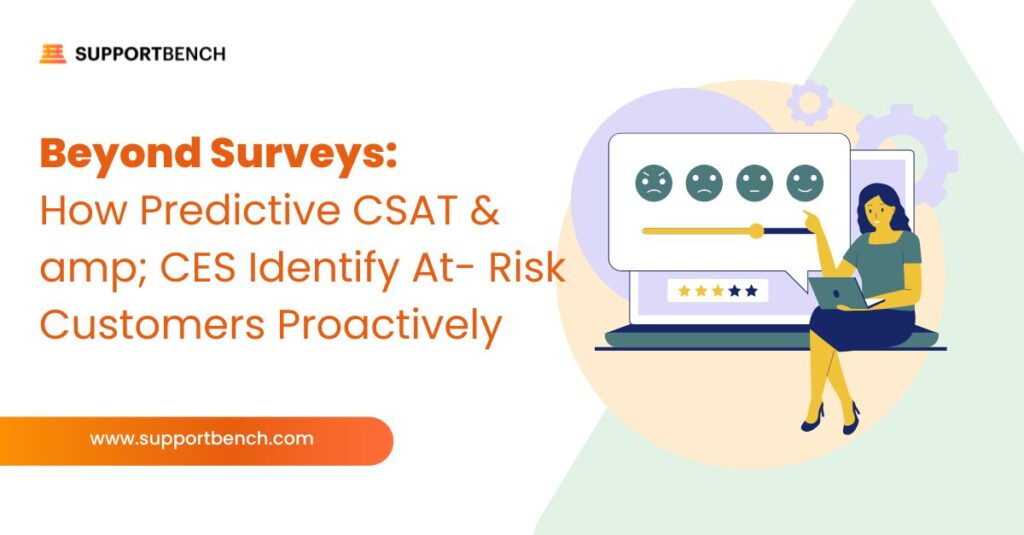For decades, customer support leaders have relied on surveys – CSAT (Customer Satisfaction), CES (Customer Effort Score), NPS (Net Promoter Score) – as primary tools to gauge customer sentiment and the effectiveness of their operations. We send them out diligently, hoping for insights into what went well and what needs improvement. But let’s be honest: how much of the complete picture are we actually capturing?
The reality is that traditional surveys often provide a limited and potentially skewed view. Industry benchmarks frequently show that even well-executed CSAT surveys struggle to achieve response rates above 20% 1. This means that for roughly 80% or more of your customer interactions, you have no direct feedback on their experience.
The feedback you do receive often suffers from response bias. Customers who take the time to respond are typically either delighted or deeply frustrated, leaving the vast middle ground – the lukewarm, the mildly inconvenienced, the quietly dissatisfied – largely unheard. This “silent majority” holds crucial insights, yet their experiences often remain invisible in survey-only reporting. Relying solely on this data can lead to a false sense of security or misdirected improvement efforts.
What if you could gain insight into the likely satisfaction and effort levels for nearly every interaction, even without a survey response? What if you could uncover hidden signals within the interaction itself that indicate potential friction or dissatisfaction? This is precisely where AI-powered Predictive CSAT and Predictive CES come into play, offering a transformative leap from reactive measurement to proactive customer experience management.

Unveiling the Unseen: How Predictive Analytics Work
Predictive CSAT and CES leverage the power of Machine Learning (ML) to analyze the rich data generated during customer support interactions and predict the likelihood of a customer being satisfied or finding the interaction effortless, regardless of whether they completed a survey.
Think of it like an experienced manager who can often sense if an interaction went poorly just by observing certain cues. AI does something similar, but systematically and at scale, by analyzing patterns across thousands or millions of interactions. Here’s a conceptual breakdown:
- Data Ingestion: The AI model is fed data from various sources related to the support interaction:
- Interaction Content: Analyzing the text of emails and chats for sentiment (positive/negative/neutral language), specific keywords (e.g., “frustrated,” “confusing,” “issue resolved,” “thank you”), complexity of language, and emotional tone.
- Interaction Metadata: Factors like case duration relative to issue type, number of agent replies, time to first response, number of transfers or escalations, whether standard resolution procedures were followed.
- Agent Actions: Steps taken within the helpdesk, knowledge articles referenced or shared.
- Historical Data: Patterns learned from past interactions where survey scores were provided, correlating specific interaction characteristics with known outcomes.
- (Optional) CRM Data: Customer segment, contract value, or previous interaction history might add further context.
- Pattern Recognition: The ML model identifies complex patterns and correlations between these data points and the likely satisfaction or effort level. For instance, it might learn that interactions involving multiple transfers, negative sentiment keywords, and longer-than-average resolution times for a specific issue type strongly correlate with low CSAT scores.
- Prediction Generation: For each interaction (or case closure), the AI generates a predictive score (e.g., Predicted Satisfied/Dissatisfied, Predicted High/Low Effort) based on the patterns detected in that specific interaction’s data.
This isn’t about mind-reading; it’s about data-driven inference based on learned correlations between interaction characteristics and likely outcomes.

The Strategic Imperative: Why Predictive Scores Matter
Moving beyond the limitations of traditional surveys unlocks significant strategic advantages, particularly for organizations focused on long-term customer relationships and retention:
Illuminating the “Silent Majority”
Predictive scores give you visibility into the likely experience of the ~80% of customers who don’t respond to surveys. This provides a vastly more comprehensive and representative understanding of overall customer sentiment and effort across your entire support operation. You can finally start finding hidden signals using AI to identify those cases that were not tackled well, even if the customer never formally complained.
Proactive Retention and Churn Reduction
This is arguably the most powerful benefit. Low predicted CSAT or high predicted CES scores act as early warning signals for potentially at-risk customers. Instead of waiting for a negative survey (which might never come) or the dreaded churn notification, you can proactively intervene.
Example: The system flags a case from a key account with a “Predicted Dissatisfied” score due to multiple back-and-forths and negative sentiment detected in the emails. Even though no survey was sent or returned, this triggers an automated alert to the designated Customer Success Manager (CSM) or an Account Manager. They can review the case (potentially aided by AI summaries – more on that below), reach out to the client proactively, acknowledge the difficult experience, ensure the underlying issue is truly resolved, and reinforce the value of the partnership. This proactive outreach can turn a potentially negative experience that might have festered into a loyalty-building moment.
More Accurate Performance Measurement
Relying solely on biased survey data gives an incomplete picture of agent and team performance. Predictive scores allow you to measure agent performance and organizational strength based on the likely outcome of all their interactions. You can identify trends: Are certain agents consistently associated with low predicted scores? Do specific issue types frequently result in predicted high effort? This provides a fairer and more holistic view than survey scores alone.
Targeted Coaching and Process Improvement
Insights derived from predictive analytics offer concrete data for coaching and operational improvements. If an agent consistently receives low predicted scores, managers can investigate, review the interactions (again, aided by summaries), and provide targeted coaching. If interactions related to a specific product feature or process consistently generate high predicted effort scores, it clearly signals an area ripe for simplification, documentation improvement, or product enhancement.

Operationalizing Predictive Insights: Making Data Actionable
Generating predictive scores is only half the battle; the real value comes from integrating these insights into your daily workflows and decision-making processes.
1. Visibility within the Workflow
Predictive CSAT/CES scores should not be hidden away in separate reports. They need to be surfaced directly within the tools your teams use every day:
- Helpdesk Interface: Display scores as columns in agent queues or on case records, allowing agents and supervisors to see the predicted sentiment at a glance.
- Dashboards & Reporting: Incorporate aggregated predictive scores into performance dashboards alongside traditional metrics for a complete view.
2. Automated Alerts and Triggers
Set up workflows based on predictive scores. For example:
- Automatically flag cases with “Predicted Dissatisfied” or “Predicted High Effort” for manager review.
- Trigger a task creation in your CRM or Customer Success Platform (like Gainsight or Catalyst) for the relevant CSM/Account Manager to follow up on low-scoring interactions from key accounts.
- Route interactions with consistently low predicted scores for a specific issue type to a quality assurance or process improvement queue.
3.Addressing the “Why”: The Role of AI Summaries
A common question arises: “The AI predicted dissatisfaction, but why?” Predictive scores indicate the likely outcome but don’t inherently provide the qualitative reasoning a survey comment might. This is where other AI features become crucial. Sophisticated platforms, like Supportbench, create AI-generated summaries of interactions or entire cases. When a manager sees a low predicted CSAT score, they can instantly click to view an AI summary highlighting the key pain points, negative sentiment phrases, or process breakdowns that likely contributed to the prediction. This provides the crucial context needed to quickly know why the AI is marking something as satisfactory or not, enabling informed follow-up without manually reading through lengthy transcripts.
4. Closing the Loop with Customer Success
Predictive insights are invaluable fuel for proactive Customer Success Management. Sharing trends or specific low scores (especially for strategic accounts) with CSMs allows them to have more informed conversations during check-ins, address potential issues before they escalate, and gain a truer sense of customer health beyond just usage data or relationship sentiment.

Building Trust in Predictions: Accuracy and Refinement
A natural question is: “How accurate are these predictions?” The accuracy depends on several factors, including the quality and volume of your interaction data, the sophistication of the AI models used by your platform vendor, and how well the models are tuned to your specific context.
It’s important to view these scores as strong indicators or predictors, not infallible judgments. They provide a probabilistic assessment. However, well-implemented models consistently demonstrate high correlations with actual customer sentiment when tested against received survey data. The key is continuous refinement – providing feedback to the system (if the platform allows) and focusing on improving the quality of the underlying interaction data helps the AI learn and improve its accuracy over time.
Embracing the Predictive Advantage
Relying solely on traditional CSAT and CES surveys in today’s data-rich environment means operating with incomplete information. You’re missing the voice of the silent majority and potentially overlooking critical risks until it’s too late.
AI-powered Predictive CSAT and CES offer a paradigm shift, moving support operations from a reactive, survey-dependent model to a proactive, data-driven approach. By analyzing the subtle signals within nearly every interaction, these tools provide unprecedented visibility into customer experience, enabling early identification of at-risk customers, more accurate performance measurement, and targeted interventions that directly impact retention and loyalty.
When combined with other AI capabilities like automated summarization to provide context, predictive analytics empower support leaders to truly understand their customers’ experiences, optimize their operations effectively, and solidify support’s role as a strategic driver of business success. It’s time to look beyond the survey and embrace the predictive power of AI.















